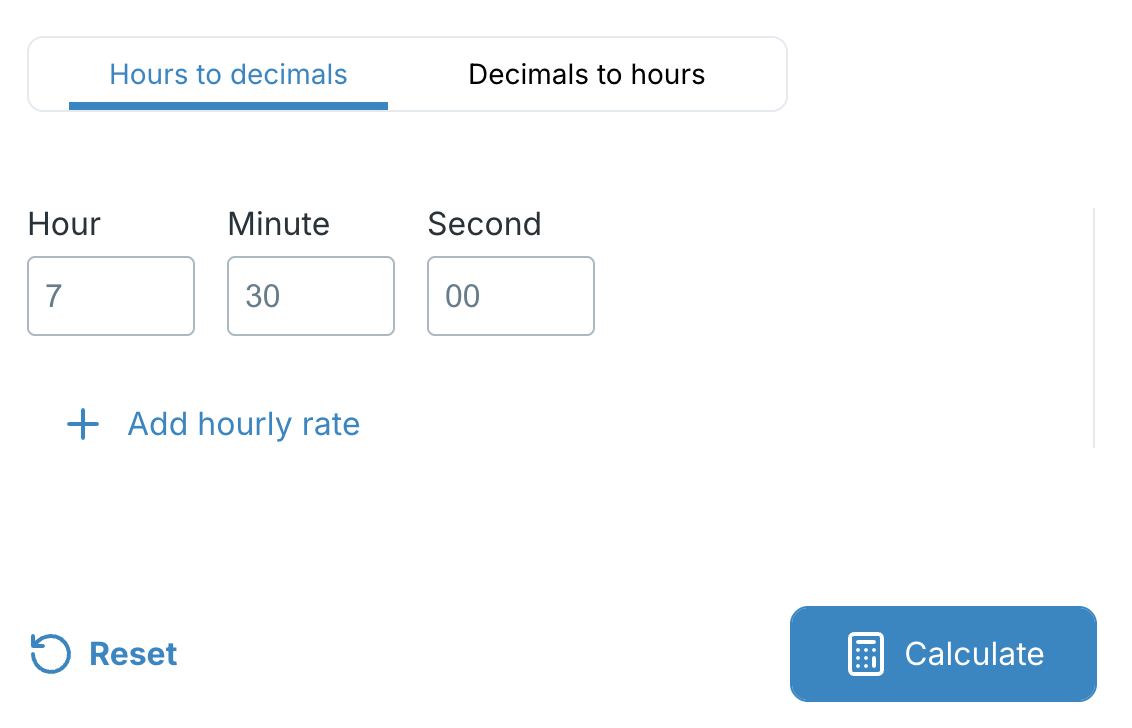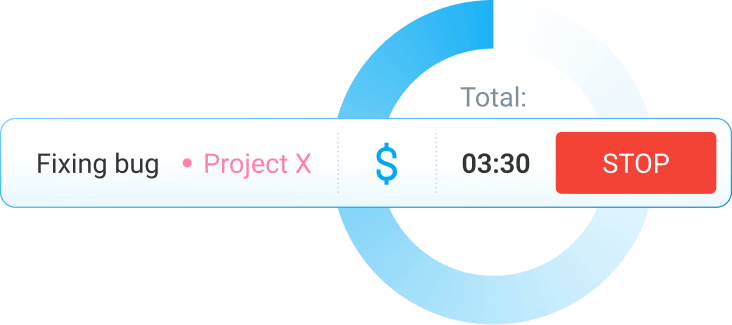Decimal Hours Converter
Do you need help converting employee hours and minutes to decimal time for payroll purposes? Manually converting minutes to decimals is a time-consuming and error-prone process. Luckily, our hours-to-decimal calculator turns time into decimals instantly.
Add hourly rate
Result
7.5 hours
As a project manager, consultant, or bookkeeper, you have to keep a record of the time employees spend on projects to ensure accurate payroll management.
To prevent incorrect calculations, you should switch from tracking hours in a regular format (HH:MM:SS) to a decimal hours system. This way, you’ll avoid incorrect payroll, billing discrepancies, or miscalculated project costs.
In this guide, we’ll explain the gist of the decimal hours system and provide you with our hours-to-decimal converter.
What is the decimal time format and who uses it?
The decimal time format shows time as regular decimal numbers. A day consists of 10 hours in the decimal time system, unlike 24 hours in a conventional time system.
So, in the decimal time format:
- A day has 10 hours,
- An hour has 100 minutes, and
- A minute has 100 seconds.
In contrast, the conventional time format shows time as hours and minutes, so:
- A day has 24 hours,
- An hour has 60 minutes, and
- A minute has 60 seconds.
In the conventional time format, 5:30 is pronounced as “five hours and thirty minutes,” which is 5.5 or “five point five” in decimal time. Later on, we’ll go over the conversion in more detail.
The decimal hours system is particularly beneficial for accountants, who use it for calculating payroll.
Apart from accounting, project managers use this system for project billing and tracking the time employees spend on a project. Also, if you’re a freelancer or a contractor, you’ll benefit from the decimal hours format because you’ll capture every billable minute.
🎓 Afraid of Undercharging? Here’s How to Bill Clients Accurately
What is the hours-to-decimal converter and how to use it?
The hours-to-decimal calculator is a tool that comes in handy when you need to quickly convert your employees’ hours and minutes into decimals. In turn, this helps you efficiently determine payroll hours for your team.
Using our hours-to-decimal converter is straightforward — there are just a couple of steps you need to complete:
- Step #1: Add the working hours in the following format HH:MM:SS, and
- Step #2: Click the Calculate button.

The decimal calculator will display the results in decimal format.

You can also convert the decimal time to hours and minutes. Just enter the decimal time and click Calculate.

How to manually convert employee work time to decimal time?
If you’re a project manager, HR coordinator, or accountant, you’ll need a reliable way to convert time to decimal. To do it manually, divide the number of minutes by 60.
The decimals are rounded, since decimal hours show only 2 decimal places.
For example, let’s see how many decimal hours 2 hours and 45 minutes are. Here’s how to do the calculation:
Let’s look at a decimal time chart for transferring minutes to decimal hours.
| Minutes | Decimal hours |
|---|---|
| 1 | 0.02 |
| 4 | 0.07 |
| 10 | 0.17 |
| 13 | 0.22 |
| 17 | 0.28 |
| 19 | 0.32 |
| 22 | 0.37 |
| 26 | 0.43 |
| 30 | 0.50 |
| 34 | 0.57 |
| 39 | 0.65 |
| 40 | 0.67 |
| 41 | 0.68 |
| 42 | 0.7 |
| 49 | 0.82 |
| 56 | 0.93 |
| 60 | 1.0 |
Luckily, with a little help from our time conversion calculator, this can be calculated automatically.
Converting employee time to decimals helps you figure out the amount you need to pay your staff, which we’ll cover in the following lines.
How to manually calculate employee pay using the decimal time system?
To determine your employees’ gross pay, you’ll need the following for the calculation:
- Their hourly rate, and
- Their working hours in decimal format.
Suppose your employee worked 2 hours and 45 minutes, like in the previous example, and their hourly rate is $10.00. To get their total gross pay, multiply your employee’s hourly rate by their total hours worked, presented in decimal format.
🎓 How to calculate labor cost + labor cost calculators
Here’s the formula:
So, the employee’s gross pay equals $27.5.
FAQs about the decimal system and troubleshooting
If you’d like to learn more about the decimal hours system, here are the most common questions about the topic.
How was the decimal time system invented?
The decimal time system was first introduced by the French on November 24, 1793, during the French Revolution. At that time, there were a lot of military and civilian engineering schools that used mathematics and science in their curricula, which could be a reason for the invention of the decimal system.
As we mentioned earlier, in the decimal time format, 1 day consists of 10 hours. One decimal hour is equivalent to 2 hours and 24 minutes in conventional time. Thus, counting time was made straightforward during the 18th century, for example:
- Noon was at 5 o’clock — since the entire day included 10 hours and noon is in the middle,
- The day was 40% over at the end of the fourth hour (or 9 hours and 36 minutes in conventional time), and
- The day was 80% over at the end of the eight hour (or 19 hours and 12 minutes in conventional time).
This method of calculating time proved inconvenient and unpopular. That’s why the French stopped using it after only 1 year and 5 months — on April 7, 1795.
But in 1897, the French tried to implement the decimal time system again. In short, this is what the Commission de Décimalisation du Temps proposed:
- A day should consist of 24 hours,
- An hour should consist of 100 minutes, and
- A minute should have 100 seconds.
Like the previous one, this proposal was withdrawn in 1900.
What are additional examples of the decimal time system?
Besides using time clock conversion for payroll, there are 2 more examples of the decimal time implementation:
- Stardates — introduced in the Star Trek franchise, and
- Swatch Internet time — introduced by the Swatch watch company.
A stardate is a fictional pseudo-decimal timekeeping system created for the Star Trek television and film franchises. The stardates in Star Trek were derived from the Julian system of the 16th century. The writers were told to choose 4 digits and a decimal for the original Star Trek series.
The Stardate calculator will help you convert any conventional date into a stardate. For example, the stardate for the:
- Year: 2025,
- Month: August,
- Date: 7,
- Hour: 12,
- Minute: 16, and
- Second: 31, is -297401.33843860985.
The Swatch company first developed the notion of Internet Time (also known as .beat time or BMT — Biel Mean Time) in 1998 for their “Beat” watches marketing campaign.
It was supposed to be a more straightforward form of global cooperation over the Internet, since it lacked time zones. The official format involves inserting a @ sign before the current .beat and ranges from @000 to @1000 .beats daily.
For example, 6 hours equals @250. beats in Internet Time.
What industries benefit the most from decimal hours conversion?
Accounting and HR teams use decimal formats to calculate payroll and employee overtime.
Apart from them, project managers benefit from the decimal system. Having all working hours in the decimal format helps them calculate project costs and invoice their clients.
🎓 11 Types of Invoices You Need for Your Business
Construction workers also use decimal format to track their work hours. They usually record their time by clocking in and clocking out at the beginning and end of their shifts.
Finally, freelancers and contractors find the decimal system practical for logging their billable and non-billable hours, which helps them bill their clients accurately.
What is 13 minutes in the decimal format?
13 minutes is 0.22 in decimals. Here’s the formula:
What is 21 minutes in decimal?
21 minutes is 0.35 in decimals. Here’s the formula:
Is the decimal hours system compliant with US labor laws?
Yes, the decimal format is fully compliant with the US laws and FLSA.
According to our interlocutor, Dominic Leto, a real estate investor from Pennsylvania, it’s also important how you round time when using the decimal hours system:
Track time and payroll accurately with Clockify
One of the safest ways to eliminate mistakes in payroll and billing is to let software do the heavy lifting. Time trackers like Clockify help you measure all employees’ activities, enabling you to handle payroll correctly.
With Clockify, your employees can record their work hours via:
- Timesheets,
- Timer,
- Time kiosk, and
- Even input hours manually.
As their manager, you can set hourly rates for your:
- Workers,
- Projects, or even
- Tasks.

Another benefit of using a payroll tracker is that you can export working hours for each worker.

You can even customize your exports to your specific needs. For example, if you don’t want to include personal information like employees’ ID numbers or PINs, you can exclude these categories from your exports with one click.

To explore other invoicing and payroll management options, like add-ons, we encourage you to visit our Marketplace.
And, if you need any help navigating Clockify, our customer support team will be happy to answer your questions 24/7.
Clockify is also available as a part of the CAKE.com Bundle, which provides 3 productivity tools at a heavily discounted price of $12.99. By opting for the Bundle, you get not only a feature-rich time tracking and team scheduling tool, but also:
- Plaky — an intuitive project management software, and
- Pumble — a sleek team communication app.
REFERENCES
- License for research — The decimalisation of Republican time. The French Revolution which failed (1793–1795) https://creativecommons.org/licenses/by/4.0/
